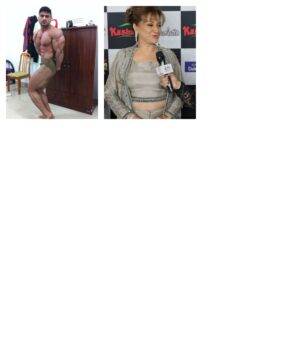
In September last year, veteran actor Bushra Ansari was scathingly targeted for exposing her midriff at the HUM Awards. The social media comments focused on “vulgarity” and for not dressing “age appropriately”. Such ageism is uncalled for in an age where every other young person is displaying their body on social media. Where young men are increasingly taking shirtless selfies, young women are wearing spandex tights that accentuate their physical attributes.
Additionally, the reaction to young men displaying their near naked bodies is completely different. Take for instance the response to the body builder Waqas Tariq posing in an extremely skimpy posing trunk. The comments on his Facebook reel are replete with “mashallah” blessings.
The point is not to shame young men for accentuating their physical attributes but to highlight the misogyny and ageism faced by women. I fail to see the problem of the young commenters who cannot digest that a woman in her sixties is living her life to the fullest. If she finds happiness in dancing at a wedding, then what does that take away from them? Ms. Ansari has every right to look and feel sexy at her age or for that matter any age.
Many social media commenters have skeletons in their own closet. Those who wail the loudest often have something to hide which they try to address by projecting their insecurities onto others. Alternatively, they try to address their shortcomings and failings by putting others down. This is a moral flaw that requires deep introspection.
As for the morality police, there is a crude Punjabi saying that “shakal changi na howey te banda gal e changi kar lenda” which is essentially used to ask people to just remain silent. It is reminiscent of the Islamic teaching to speak kindly or to stay silent. Such religious and cultural teachings are needed for social media commenters who have not been brought up with adab (etiquette) to guard their tongues.
Additionally, the reaction to young men displaying their near naked bodies is completely different. Take for instance the response to the body builder Waqas Tariq posing in an extremely skimpy posing trunk. The comments on his Facebook reel are replete with “mashallah” blessings.
The point is not to shame young men for accentuating their physical attributes but to highlight the misogyny and ageism faced by women. I fail to see the problem of the young commenters who cannot digest that a woman in her sixties is living her life to the fullest. If she finds happiness in dancing at a wedding, then what does that take away from them? Ms. Ansari has every right to look and feel sexy at her age or for that matter any age.
Many social media commenters have skeletons in their own closet. Those who wail the loudest often have something to hide which they try to address by projecting their insecurities onto others. Alternatively, they try to address their shortcomings and failings by putting others down. This is a moral flaw that requires deep introspection.
As for the morality police, there is a crude Punjabi saying that “shakal changi na howey te banda gal e changi kar lenda” which is essentially used to ask people to just remain silent. It is reminiscent of the Islamic teaching to speak kindly or to stay silent. Such religious and cultural teachings are needed for social media commenters who have not been brought up with adab (etiquette) to guard their tongues.

